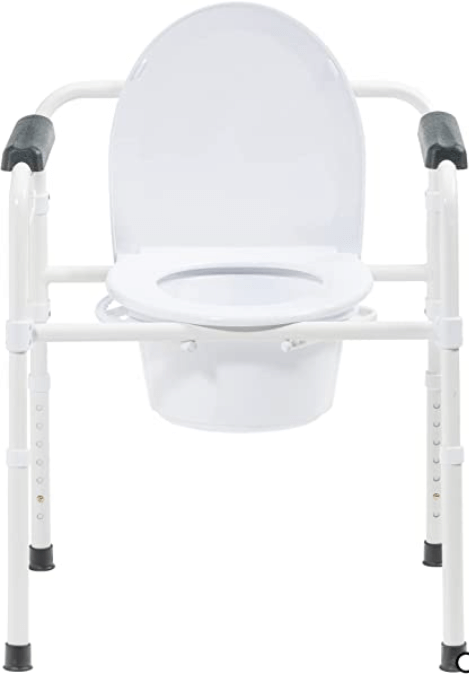Within the realm of personal stand-up aid equipment, there exists a vast array of tools designed to assist seniors and individuals with disabilities. We previously provided an overview of the most prevalent types of toilet standing aids, and among these, we talk in this article about over-the-toilet commode chairs.
We will discuss the type of support they provide and who they’re designed for.
Who needs and when to choose an Over the Toilet Commode Chair ?

Over-the-toilet commode chairs are not a one-size-fits-all solution, but rather, they are most useful under specific circumstances.
The over-the-toilet commode chair is a versatile, movable device that can serve a multitude of needs, particularly beneficial for individuals such as the elderly and those with mobility impairment.
The commode chair is especially useful for people recovering from significant medical procedures like knee or hip replacements, leg or back surgeries, or any other type of operation that may temporarily or permanently impact mobility.
However, if the primary need is for minor assistance with balance while sitting down or standing up, safety rails or grab bars may be a more appropriate, less intrusive solution. ( grab bars can be better for those who have smaller bathrooms where space is a constraint ).
If you wonder about choosing wheter raised toilet seats or over-the-toilet commode chairs. Know that the latter are equipped with a commode bucket and can be conveniently relocated to any room, so the risk of tripping is reduced.
This is particularly beneficial for those experiencing chronic weakness or who are at a heightened risk of falls because it can significantly reduce the distance they need to travel.
How to Select an over the toilet commode chair:
Selecting an over the toilet commode chair involves carefully considering various factors that influence its functionality and comfort. Here are some aspects to consider when making your selection:
1. Comfort The seat should be wide enough to accommodate the user without constriction, while also being padded to provide cushioning. The backrest should offer enough support to allow the user to rest comfortably. Armrests should be padded and at a height that suits the user’s natural arm position to aid in both sitting and standing.
2. Adjustability It should be adjustable to different users or different toilet heights. Some chairs even offer adjustable armrests and footrests, allowing for a more personalized setup that fits the user’s specific body proportions and mobility needs.
3. Commode Cover: The existance of a commode cover is a significant factor to consider. It helps maintain a semblance of normalcy and discretion when the chair is not in use. This also ensures hygiene and privacy during the transportation process for emptying the commode.
4. Sturdiness and Durability: The chair must be sturdy enough to support the user’s weight and endure regular use.
Typically, materials such as aluminum, stainless steel, or hardened plastic are recommended due to their strength and durability. Aluminum is lightweight yet robust, stainless steel offers unmatched durability, and hardened plastic can provide a good balance between weight and stability. These materials also resist corrosion, which is excellent in a moisture-prone environment like a bathroom.
Although chairs made from these high-quality materials may be more expensive, they’re a worthwhile investment for long-term or permanent use. For short-term needs, you have to find a balance between the price and the quality of materials.
5. Size: Primarily, the seat width and depth should be adequate to comfortably accommodate the user, it should provide enough room for movement without causing discomfort.
The chair should not be too narrow that it’s uncomfortable to sit on, or too wide that it fails to provide necessary support.
Then, the overall dimensions of the chair should be such that it fits well within the available space in the bathroom or wherever it is intended to be used. If the chair is too large, it may restrict mobility in the room or become a tripping hazard.
Types of Commode Chairs:
1. Portable Over The toilet :

This over the toilet commode is an excellent solution for those in need of a portable commode because it can be used next to the bedside.
As it is portable, it comes with a lid and splash guard for more hygienic purpose.
2. Foldable Bedside Commode

The foldable ones can be easily stored and reopened as needed. This is recommended when space is limited or when expecting visitors.
3. Mobile Commode Chairs

The wheels allow the commode chair to be moved from the room to the toilet, which can be helpful for seniors who are able to transfer themselves with self-propelled motion.
Wrapping It All Up:
We hope this guide about over the toilet commode chairs has been helpful in your search for the perfect one. Do not forget that beyond over-the-toilet commode chairs, there are many other assistive devices designed to help seniors at home.

A seasoned SEO specialist and a writer for gaming, senior well-being, and ride-on toys. With an analytical mind, sharpened by 14 years of experience as a finance controller. His unique ability to create engaging content is only exceeded by his skill in leveraging SEO strategies, a talent driven by his love for numbers and patterns.









